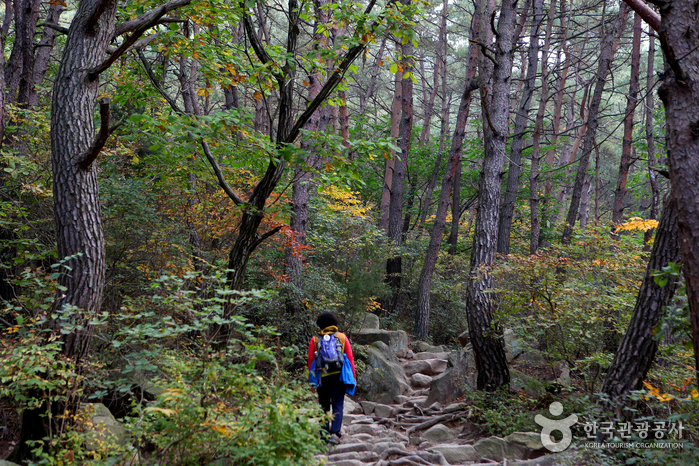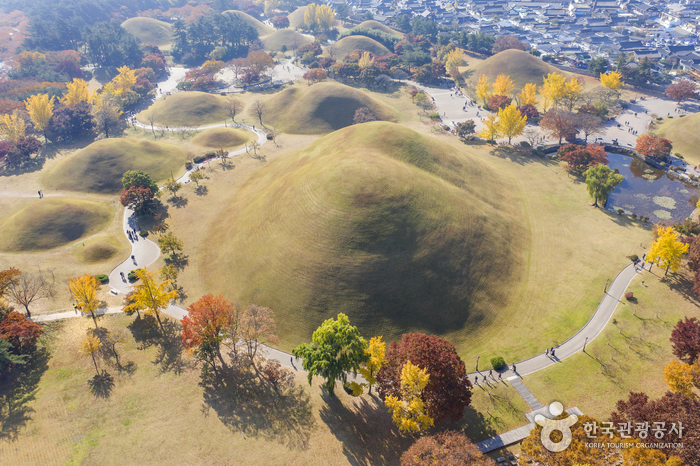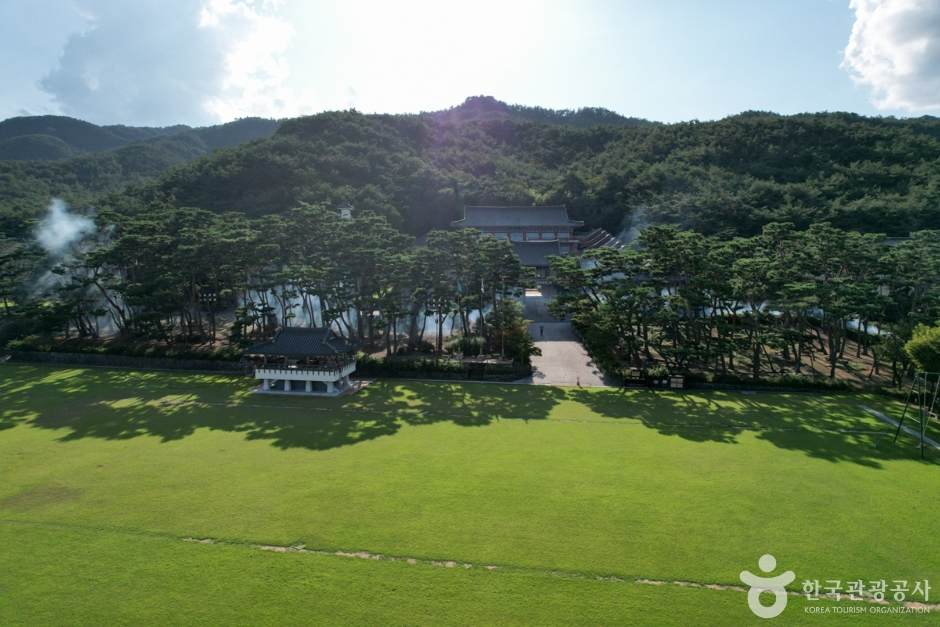Gyongju Folk Craft Village (경주민속공예촌)
5.1Km 2025-06-12
230 Bobul-ro, Gyeongju-si, Gyeongsangbuk-do
Gyeongju Folk Craft Village, nestled at the foot of Tohamsan Mountain in Gyeongju, is a traditional folk craft village consisting of around fourty Korean traditional houses including thatched-roof and tiled-roof houses. Skilled artisans proficient in traditional arts and crafts gather here to produce and sell ceramics, woodcrafts, jewelry, hanbok, stone crafts, and more. Visitors can also participate in hands-on crafting experiences. The village's Silla Art and Science Museum showcases artifacts from the Silla dynasty, while nearby attractions include the Bomun Tourist Complex, Bulguksa Temple, and Seokguram Grotto.
Silla Arts and Science Museum (신라역사과학관)
5.3Km 2025-06-12
33 Hadonggongyechon-gil, Gyeongju-si, Gyeongsangbuk-do
+82-54-745-4998
Silla Arts and Science Museum, opened in 1988, displays miniature models of scientific cultural assets in order to explore and educate how these assets are formed and preserved.
Tongiljeon Ginkgo Road (통일전 은행나무길)
8.1Km 2025-02-04
6 Chilburam-gil, Gyeongju-si, Gyeongsangbuk-do
Tongiljeon Ginkgo Road is a tree-lined road approximately 2 kilometers long in front of the Tongiljeon Hall, a building erected to commemorate the unification of the Three Kingdoms under Silla. The street is one of the best autumn destinations in Gyeongju, with ginkgo trees lined up on both sides of the road. During fall, the trees create a beautiful scene with their brilliant yellow leaves. The road is perfect for a leisurely drive or a walk, and from Tongiljeon Hall, visitors can enjoy a panoramic view of the entire ginkgo tree-lined path.
Gyeongju Namsan Mountain (경주 남산)
8.4Km 2024-02-27
Namsan Mountain of Gyeongju (경주 남산)
+82-54-771-7142
Namsan Mountain of Gyeongju is a 466-meter mountain located south of the Gyeongju city center. Gyeongju was the capital of the Silla dynasty (BC 57-AD 935) from its inception to its end. The Silla people revered this mountain, considering it sacred, and left many traces of their presence, resulting in numerous cultural relics that still exist today. Therefore, visitors can enjoy both hiking and cultural heritage sightseeing on this mountain.
Gyeongju-si Special Tourist Zone (경주시 관광특구)
8.5Km 2025-03-25
614 Gyeonggam-ro, Gyeongju-si, Gyeongsangbuk-do
+82-54-779-6084
Gyeongju was the capital city of the ancient kingdom of Silla. The city is often referred to as a “museum without walls” because of the many cultural relics scattered throughout the city. Almost everything in this city, from the streets to the mountains, is rich in history. Gyeongju has roughly 300 sites that have been designated as a cultural heritage, with some of them being UNESCO-recognized World Heritage Sites.
The Gyeongju Special Tourist Zone includes the districts of Namsan, Wolseong, Daereungwon, Hwangryongsa, and Sanseong. This area has a total of 52 cultural assets registered on the World Heritage list. Many of the hills are actually royal tombs and fields of grass used to be sites of ancient temples.
The entire Namsan Mountain can almost be considered a cultural asset because of the many stone pagodas and Buddha statues that can be found here. The Bulguk district is home to many of Gyeongju’s most well-known attractions such as Bulguksa Temple, Seokguram Grotto, Gyeongju Folk Village, Silla Arts and Science Museum, and Goereung.
In the Bomun district, there are plenty of recreation facilities surrounding Bomunho Lake. Other attractions in the area include Gyeongju World Culture Expo Park, Gyeongju World, and Silla Millennium Park.
[Gyeongju Special Tourist Zone]
Areas included: Downtown area, Bomun Lake Resort, and Bulguksa Temple in Gyeongju-si, Gyeongsangnam-do
Area size: 32,650,000㎡
Tourist Attractions: Bulguksa Temple, Seokguram Grotto, Daereungwon Tomb Complex, Namsan Mountain, Bomunho Lake, Shilla Millennium Park, Gyeongju World Culture Expo Park, etc.
Gyeongju Expo Park (경주엑스포공원)
8.5Km 2024-11-11
614 Gyeonggam-ro, Gyeongju-si, Gyeongsangbuk-do
Gyeongju Expo Park is located in the Bomun Tourist Complex in Gyeongju, offering a thematic experience of Korean culture through exhibitions, performances, and hands-on activities showcasing the art and culture of the Silla dynasty (BC 57-AD 935). The park features various attractions such as Gyeongju Tower, Timeless Media Art, Solgeo Art Museum, Lumina Night Walk, Cheomseongdae Film Hall, and Asadal Sculpture Park.
Hwarang Institute (화랑교육원)
8.7Km 2024-02-23
62 Saenamsan-gil, Gyeongju-si, Gyeongsangbuk-do
Hwarang Institute is Korea's first character education organization. It aims to inherit the spirit of the Silla dynasty's Hwarang, a youth warrior group, and to cultivate good character and personality in children. Its facilities include Hwarang Hall, a playground, an auditorium, and a Safety Education Hall. Notably, the Safety Education Hall features an earthquake experience room, a life-saving room, and a 4D video room, where children can receive effective preventive safety education on health, crime, and natural disasters. Nearby tourist attractions include the Gyeongju National Museum, the Tomb of King Jeonggang, Gyeongju Millennium Forest Garden, and the Tomb of King Gyeongae.
Gyeongju Expo Solgeo Art Museum (경주솔거미술관(솔거미술관))
8.7Km 2025-05-19
614 Gyeonggam-ro, Gyeongju-si, Gyeongsangbuk-do
Gyeongju Expo Solgeo Art Museum is Gyeongju’s first public art museum, opened in 2015 with the donation of 830 works by the Korean painter Park Dae-sung. Designed by the renowned architect Seung H-Sang, the museum’s architecture blends people, space, and nature. It features a permanent exhibition of works by Park Dae-sung, along with special rotational exhibitions by invited artists. For visitors seeking deeper insight into the artwork, the museum offers a docent program. The window in the permanent exhibition hall has become a popular SNS spot and is often referred to as a moving painting.
Salon Heritage (살롱헤리티지)
8.7Km 2025-05-26
614 Gyeonggam-ro, Gyeongju-si, Gyeongsangbuk-do
Salon Heritage is a world cultural heritage media promotion hall, located inside the Gyeongju World Expo Memorial, which was designed by renowned architect Kengo Kuma, drawing inspiration from Daereungwon Ancient Tombs and columnar joints of Gyeongju. It features dynamic media walls, a media tunnel and a world heritage study, offering visitors an immersive digital experience to explore the rich heritage of Gyeongju.




 English
English
 한국어
한국어 日本語
日本語 中文(简体)
中文(简体) Deutsch
Deutsch Français
Français Español
Español Русский
Русский